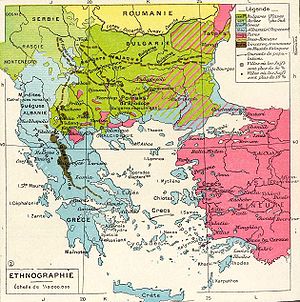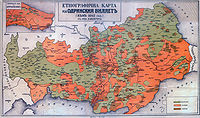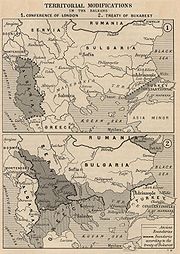
The Destruction of Thracian Bulgarians in 1913
Encyclopedia



Thracian Bulgarians
Thracians or Thracian Bulgarians is a regional, ethnographic group of ethnic Bulgarians, inhabiting or originating from Thrace. Today, the larger part of this population is concentrated in Northern Thrace, but much is spread across the whole of Bulgaria and the diaspora...
in 1913" (in Bulgarian
Bulgarian language
Bulgarian is an Indo-European language, a member of the Slavic linguistic group.Bulgarian, along with the closely related Macedonian language, demonstrates several linguistic characteristics that set it apart from all other Slavic languages such as the elimination of case declension, the...
"Разорението на тракийските българи през 1913 година") were events described by Bulgarian academician Lyubomir Miletich
Lyubomir Miletich
Lyubomir Miletich was a leading Bulgarian linguist, ethnographer, dialectologist and historian, as well as the chairman of the Bulgarian Academy of Sciences from 1926 to his death....
in 1918, but also mentioned by Carnegie Endowment for International Peace
Carnegie Endowment for International Peace
The Carnegie Endowment for International Peace is a foreign-policy think tank based in Washington, D.C. The organization describes itself as being dedicated to advancing cooperation between nations and promoting active international engagement by the United States...
with also a detailed report on the annihilation of Thracian Muslims. They included ethnic cleansing
Ethnic cleansing
Ethnic cleansing is a purposeful policy designed by one ethnic or religious group to remove by violent and terror-inspiring means the civilian population of another ethnic orreligious group from certain geographic areas....
, caused to the Bulgarian population in East Thrace
East Thrace
East Thrace or Eastern Thrace , also known as Turkish Thrace, is the part of the modern republic of Turkey that is geographically part of Europe, all in the eastern part of the historical region of Thrace; most of Turkey is in Anatolia, also known as Asia Minor. Turkish Thrace is also called...
and Eastern Rhodope Mountains
Rhodope Mountains
The Rhodopes are a mountain range in Southeastern Europe, with over 83% of its area in southern Bulgaria and the remainder in Greece. Its highest peak, Golyam Perelik , is the seventh highest Bulgarian mountain...
(now mainly in Edirne Province
Edirne Province
Edirne Province is the westernmost province of Turkey, located in Eastern Thrace along the Greek and Bulgarian border. The city's wealth, population and importance increased after it was declared as the capital city of the Ottoman Empire...
, Kırklareli Province
Kirklareli Province
Kırklareli Province is a province in northwestern Turkey on the west coast of the Black Sea. The province neighbours Bulgaria to the north along a 180 kilometers long border. It borders the province of Edirne to the west and the province of Tekirdağ to the south and province of Istanbul to the...
and Tekirdağ Province
Tekirdag Province
The Tekirdağ Province is in Trakya , the northwestern part of Turkey. The capital city is Tekirdağ. It is famous for its meatball called "Tekirdağ köfte" and the Turkish alcoholic drink called Tekirdağ rakısı.-Districts:...
in Turkey
Turkey
Turkey , known officially as the Republic of Turkey , is a Eurasian country located in Western Asia and in East Thrace in Southeastern Europe...
and in Evros Prefecture
Evros Prefecture
Evros is one of the regional units of Greece. It is part of the region of East Macedonia and Thrace. Its name is derived from the river Evros, which appears to have been a Thracian hydronym. Evros is the northernmost regional unit. It borders Turkey to the east, across the river Evros, and it...
in Greece
Greece
Greece , officially the Hellenic Republic , and historically Hellas or the Republic of Greece in English, is a country in southeastern Europe....
) during the Second Balkan War
Second Balkan War
The Second Balkan War was a conflict which broke out when Bulgaria, dissatisfied with its share of the spoils of the First Balkan War, attacked its former allies, Serbia and Greece, on 29 June 1913. Bulgaria had a prewar agreement about the division of region of Macedonia...
and in a short period after it.
History
When the military actions between SerbiaSerbia
Serbia , officially the Republic of Serbia , is a landlocked country located at the crossroads of Central and Southeast Europe, covering the southern part of the Carpathian basin and the central part of the Balkans...
, Greece
Greece
Greece , officially the Hellenic Republic , and historically Hellas or the Republic of Greece in English, is a country in southeastern Europe....
, Montenegro
Montenegro
Montenegro Montenegrin: Crna Gora Црна Гора , meaning "Black Mountain") is a country located in Southeastern Europe. It has a coast on the Adriatic Sea to the south-west and is bordered by Croatia to the west, Bosnia and Herzegovina to the northwest, Serbia to the northeast and Albania to the...
and Romania
Romania
Romania is a country located at the crossroads of Central and Southeastern Europe, on the Lower Danube, within and outside the Carpathian arch, bordering on the Black Sea...
against Bulgaria
Bulgaria
Bulgaria , officially the Republic of Bulgaria , is a parliamentary democracy within a unitary constitutional republic in Southeast Europe. The country borders Romania to the north, Serbia and Macedonia to the west, Greece and Turkey to the south, as well as the Black Sea to the east...
were in full progress, the Ottoman Empire
Ottoman Empire
The Ottoman EmpireIt was usually referred to as the "Ottoman Empire", the "Turkish Empire", the "Ottoman Caliphate" or more commonly "Turkey" by its contemporaries...
took advantage of the situation to recover some of its former possessions in Thrace
Thrace
Thrace is a historical and geographic area in southeast Europe. As a geographical concept, Thrace designates a region bounded by the Balkan Mountains on the north, Rhodope Mountains and the Aegean Sea on the south, and by the Black Sea and the Sea of Marmara on the east...
including Edirne
Edirne
Edirne is a city in Eastern Thrace, the northwestern part of Turkey, close to the borders with Greece and Bulgaria. Edirne served as the capital city of the Ottoman Empire from 1365 to 1453, before Constantinople became the empire's new capital. At present, Edirne is the capital of the Edirne...
. In the beginning of July 1913 its forces crossed the Bulgarian border on the line Kıyıköy
Kiyiköy
Kıyıköy, formerly Midye, ancient/medieval Medea , is a town of the district of Vize in Kırklareli Province in northwestern Turkey. It is situated on the coast of the Black Sea. It became a municipality in 1987. The population of the town is 2,443 according to the 2000 National Census.Fishing and...
- Enez
Enez
Enez is a district of Edirne Province, Turkey, as well as the name of the center-town of the district. Its ancient name was Aenus. The mayor is Ahmet Çayır . The population is 3,826 as of 2010....
, settled by the Treaty of London in May 1913. Because the Bulgarian troops had all been allocated to the front with Serbia and Greece, the Ottoman armies suffered no combat casualties and moved northwards and westwards without heavy battles. Thus reoccupied territories were given back to the Ottoman Empire by the Treaty of Constantinople
Treaty of Constantinople (1913)
The Treaty of Constantinople was a treaty between the Ottoman Empire and the Kingdom of Bulgaria signed on 29 September 1913 after the Second Balkan War at the Ottoman capital İstanbul.- Background :...
, signed on September 16. Despite that, the mass extermination and ethnic cleansing
Ethnic cleansing
Ethnic cleansing is a purposeful policy designed by one ethnic or religious group to remove by violent and terror-inspiring means the civilian population of another ethnic orreligious group from certain geographic areas....
continued in the areas, regained by the Ottomans, even after this date. Shortly after the end of the hostilities Miletich interviewed hundreds of refugees from these regions, travelled himself in the places where these tragic events happened and systematically depicted in detail the atrocities, made from the Young Turks
Young Turks
The Young Turks , from French: Les Jeunes Turcs) were a coalition of various groups favouring reformation of the administration of the Ottoman Empire. The movement was against the absolute monarchy of the Ottoman Sultan and favoured a re-installation of the short-lived Kanûn-ı Esâsî constitution...
' regular army, Ottoman paramilitary forces and partly from local Greeks
Greeks
The Greeks, also known as the Hellenes , are a nation and ethnic group native to Greece, Cyprus and neighboring regions. They also form a significant diaspora, with Greek communities established around the world....
. As a result in 1913 46,786 Bulgarians left East Thrace
East Thrace
East Thrace or Eastern Thrace , also known as Turkish Thrace, is the part of the modern republic of Turkey that is geographically part of Europe, all in the eastern part of the historical region of Thrace; most of Turkey is in Anatolia, also known as Asia Minor. Turkish Thrace is also called...
for Bulgaria and 48,578 Moslems emigrated from Western Thrace to Turkey.The entire community of the Thracian Bulgarians in these regions, where they were relative ethnic majority before the Balkan wars, was wiped out.
External links
- On-line publication of the phototype reprint of the first edition of this book in Bulgarian here (in Bulgarian "Разорението на тракийските българи през 1913 година", Българска академия на науките, София, Държавна печатница, 1918 г.; II фототипно издание, Културно-просветен клуб "Тракия" - София, 1989 г., София; in English: "The Destruction of Thracian Bulgarians in 1913", Bulgarian Academy of SciencesBulgarian Academy of SciencesThe Bulgarian Academy of Sciences is the National Academy of Bulgaria, established in 1869. The Academy is autonomous and has a Society of Academicians, Correspondent Members and Foreign Members...
, Sofia, State printing house, 1918; II phototype edition, Cultural and educational club "Thrace" - Sofia, 1989, Sofia).

